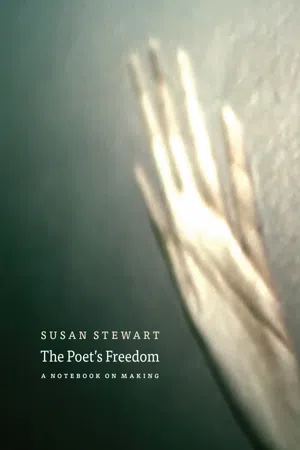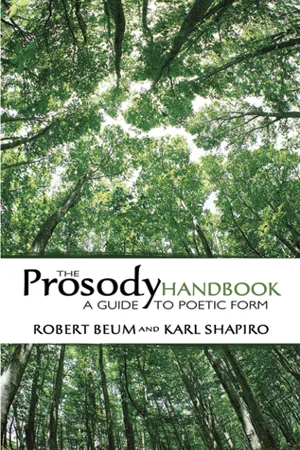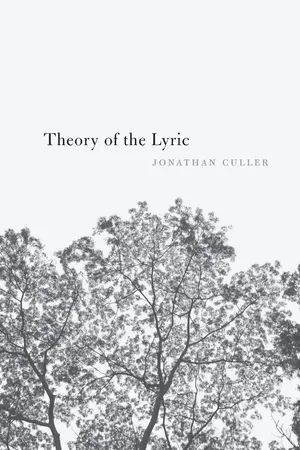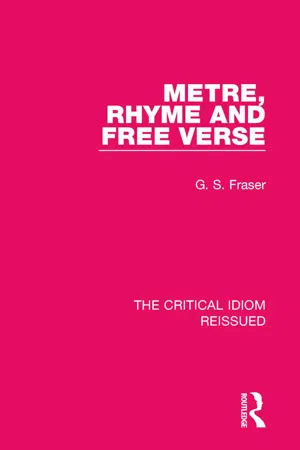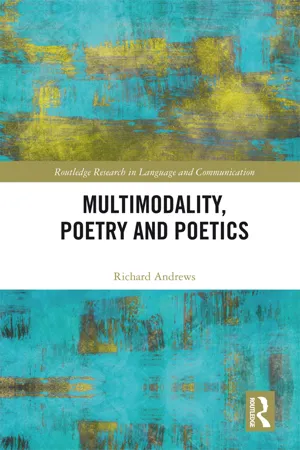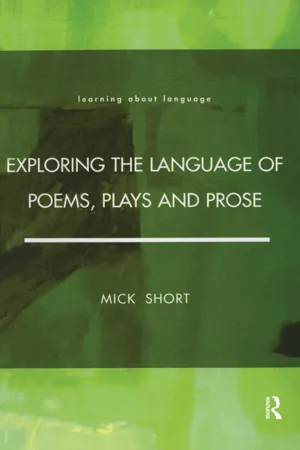Languages & Linguistics
End Rhyme
End rhyme refers to the rhyming of the final words of lines in a poem or song. It is a common poetic device used to create rhythm and musicality in the text. End rhyme is often denoted by letters to indicate the pattern, such as AABB or ABAB.
Written by Perlego with AI-assistance
7 Key excerpts on "End Rhyme"
Learn about this page
Index pages curate the most relevant extracts from our library of academic textbooks. They’ve been created using an in-house natural language model (NLM), each adding context and meaning to key research topics.
- eBook - ePub
The Poet's Freedom
A Notebook on Making
- Susan Stewart(Author)
- 2011(Publication Date)
- University of Chicago Press(Publisher)
But as we have seen, rhyme does not have to show up at the ends of words or the ends of lines. And if it doesn’t, the ends of lines are of course marked by measure, or ratio, or reason alone. Lines without rhyme or reason in this sense have to have some other means of ending—perhaps a dogma of “breath” or an adherence to prose syntax. Nevertheless, line-End Rhyme seems linked broadly to the kinds of paralinguistic marking we find in clapping, stamping, and clicking speech play in many cultures, from the clicking markers that nursing mothers use in Chinese nursery rhymes to the recent fad for singing “Happy Birthday” in American restaurants with each phrase marked by a collective hand clap. 41 Clapping, stamping, and clicking indeed emphasize the relation between our bodily symmetry and symmetrical sounds—like nonsense phonemes, they can be considered a secondary level of rhythmic punctuation. And once rhyme accrues around phonemes that are also morphemes, it becomes an indispensable and attached dimension of the poem’s meaning. We could argue inversely that nonsemantic forms of punctuated sound become meaningful as they appear in poems. This is yet another way that poiesis keeps us ahead of the existing possibilities of a language, giving us the freedom to create meanings where there are none and deny them where they may seem to appear. When words are used at once linguistically and paralinguistically, separations between speech and sound do not hold, and the performative power of words is strengthened. Line-End Rhyme thus involves subduing or suppressing rhymes that occur elsewhere, as hearing rhymes in poetic forms involves subduing or suppressing rhymes in the spoken language in general. We could conclude that a rhyme is a rhyme only if it is heard as one, but we can also think of rhyme as a vector of arbitrariness and sound for its own sake that is always latent in any utterance - eBook - ePub
The Prosody Handbook
A Guide to Poetic Form
- Robert Beum, Karl Shapiro(Authors)
- 2012(Publication Date)
- Dover Publications(Publisher)
11The Uses of Rhyme
I. RHYME AND ATTENTION
When things work out as they should, a work of art—be it a poem, a play, a picture, a sonata—elicits our complete attention. In fact, this condition of “wrapt attention,” as Eliseo Vivas has termed it, is one of the essential characteristics of all aesthetic experience. We are held. Rhyme, at the same time that it is performing various other functions, helps rivet our attention. A pattern of parallels in sound color is set up, and as we move through the poem, whether in reading or in listening, our expectation is continually being raised and then satisfied. Ideally, rhyme helps pull us through and pull us in deeper, as we anticipate the scheme. This principle holds true even in the case of a highly irregular arrangement of the rhyme words: we still feel ahead, expecting the sound colors to find their mates somewhere. Meter, refrains, and all other parallel or repeated elements work to the same advantage.If the rhyme words are also completely effective—completely flawless in terms of meaning, logically and imaginatively right—then they are also integral parts of the poem’s vitality, and not simply a mechanical convenience; they are not then ornaments, but part of the very tissue.II. MUSICAL QUALITY
Rhyme creates an effect which is pleasing and satisfying and which, by analogy, is traditionally referred to as musical or melodic quality.Euphonious rhymes (e.g., full–wool ) are undoubtedly felt as more melodic than others, but since a certain pleasure comes about as a result of the mere fact of agreement, even words of harsh quality (scratch-batch ) seem to lose some of their harshness in the pleasure that comes about when they are rhymed.Rhyme is thus a source of acoustic pleasure, and this pleasure will exist in any rhyming poem, independently of anything else in it. This pleasure, the tone or emotional coloring created by rhyme, may be described if not very accurately defined by words such as charm, sweetness, and harmony. But, to repeat, this musicality derives from the sheer fact - eBook - ePub
- Jonathan Culler(Author)
- 2015(Publication Date)
- Harvard University Press(Publisher)
Contrasting the rhyming practice of Chaucer and other poets, who are not attempting witty, semantically productive rhymes, with that called for by Pope, James Wimsatt distinguishes two systems of sound in poetry: in the symbolic system, phonemes and intonation patterns carry meaning through differential organization of the sound plane, but in the prosodic system, which includes line division, syllable count, stress, rhyme, and refrain, sounds produce what “may be called music, not for employing a harmonic or melodic organization of tones but for its mathematical organization of phonetic units, sometimes marked by stress and rhyme.” There may be local semantic effects but its main effect is iconic rather than semantic: it is self-reflexive and nonsymbolic, signifying the instantiation of poetry but not directly related to verbal meaning. Describing the increasing and subsiding density of rhymes in John Skelton’s two- and three-beat lines, Susan Stewart notes that the insistent rhymes of “Mistress Margaret Hussey” “effect the turns and metamorphoses of praise by something akin to uttering spells”:Merry Margaret, As midsummer flower, Gentle as falcon Or hawk of the tower With solace and gladness, Much mirth and no madness …Rhyme is “always a showcase for the arbitrary nature of the sign and limits our efforts to dominate meaning; rhyming draws us beyond ourselves with its potential for aural pleasure.”73Rhymes mark out lines and stanzas, contributing in a major way to rhythm (rhyme and rhythm both come from rhythmus), and they work to signify, iconically, the poetic event. Hegel identifies an erotic, teasing dimension to rhyme: in the different stanza forms of lyric, “it is as if the rhymes now find one another immediately, now fly from one another and yet look for one another, with the result that in this way the ear’s attentive expectation is now satisfied without more ado, now teased, deceived, or kept in suspense owing to the longer delay between rhymes, but always contented again by the regular ordering and return of the same sounds.” Mallarmé treats this structure as magical: “one cannot deny the similarity between the circle perpetually opening and closing with rhymes and the circles in the grass left by a fairy or magician.”74Whether we call it magic or not, one effect is to lend authority to lyric pronouncements. It is no accident that so many proverbs rhyme: “A stitch in time saves nine,” not eight or ten. The rap artist Jay-Z notes that rhyming allows hip-hop to contain contradictions and “make sense of the world in a way regular speech can’t.” He contrasts his spoken introduction to a song, which offers the beginning of an argument (“You can agree or disagree”) with a line from the song itself:I’d rather die enormous than live dormant / that’s how we on it.“That’s it. No argument. It is what it is. Why? The rhyme convinces you. The words connect. That simple couplet takes the idea of the spoken intro and makes it feel powerful, almost unassailable. Think about it: O. J. Simpson might be a free man today because ‘glove don’t fit’ rhymed with ‘acquit.’ It was a great sound bite for the media, but it was also as persuasive as the hook on a hit song. That’s the power of rhymes.”75 - eBook - ePub
- G. S. Fraser(Author)
- 2017(Publication Date)
- Routledge(Publisher)
5RhymeIn pure stress verse we saw that the function of alliteration was to link two half lines of verse together and to define, or isolate, the two linked halves as a line of verse, not a piece of prose. In Skelton, the two half lines became separate two stress lines and were linked by end-rhymes, sometimes a great string of these, instead of by alliteration. Broadly speaking the main function of rhyme in English stress-syllable verse is the same as the function of alliteration: to define or isolate the individual line of verse, and also to link different lines of verse together. But the linkages possible through rhyme are of a much more various and interesting kind than the linkages possible through alliteration. I think it impossible, unless the English language undergoes very great changes, that any English poet should in the foreseeable future write a line of verse which is not basically either a pure stress line, a stress-syllable line, a quantitative line (or an accentual imitation of one) or a line based metrically on syllable count. But any poet at any time may invent a new stanza form, or may alter the various traditional arrangements of rhyme in a form like the sonnet. And if we make allowance, as we did in the last chapter, for off-stress rhyme and half-rhyme or off-rhyme, for assonance and consonance, our notion of what rhyme is and can do will be enlarged: we can also profit by extending our idea of the position of rhyme. It is only by a convention, for instance, that lines of verse rhyme at the end rather than at the beginning; and internal rhyme is a common and effective phenomenon.In traditional English stress-syllable verse, however, rhyme is usually at the end of the line, and two words are said to rhyme when their main vowel, of main stress, and any consonants which may follow it, coincide, but their initial consonant or consonants are different: as no, so, can, ban, long, song, length, strength. Words which are exactly the same in sound though different in sense, like rose, the flower, and rose, the preterite of the verb rise, are not thought proper rhymes in English, though in French verse, as rime riche, they are an ornament: we accept, however, rhymes like rose and grows, love and glove. Such rhymes on one strong syllable are called masculine rhymes. Rhymes like pretty and witty, roses and poses, are called feminine rhymes: rhymes like niminy, piminy, prettily, wittily, rosily, cosily, are called triple rhymes, and their use is generally confined to light or comic verse. Rhymes of more than three syllables, like visibility, risibility - eBook - ePub
- Richard Andrews(Author)
- 2018(Publication Date)
- Routledge(Publisher)
The metre is basically iambic pentameter. But the rhythmic pattern is varied, giving the impression of a conversational, colloquial voice in action. The first line and a half set the template for such variation: “I wonder by my troth, what thou, and I/Did, till we lov’d?” There is both syntactic variation within the first line, and the emphatic “did” at the beginning of the second sets that line off on a different rhythm, drawing the metrical pattern back to that of a speaking voice. Throughout the poem, there are enjambements to reinforce the prose-like colloquial tone, sometimes punctuated with a comma and sometimes not: “Where can we finde two better hemispheares/Without sharpe North”. And punctuation with question marks, full stops, semicolons and commas, as well as the elisions within and between words (“desir’d”, “t’was”), enable the writing to stand in dynamic relation to its musical properties.Finally, the movement of the language is critical to the sense. In the couplet, “For love, all love of other sights controules,/And makes one little roome, an every where”, the very first word is a continuation of the argument via the logical connective ‘for’. The metaphysical leap from “one little roome” to “an every where” (the particularization of ‘an’ makes it all other possible worlds, not just a vague ‘everywhere’) is managed within one compact line and leads on to further lines about explorers, maps and “worlds on worlds”. So syntax, working with metre, indicates moves that are articulated (both in the sense of expressed and joined) within each stanza by musical/dance patterning and within each sentence and line (again working in concert).Rhythm in Poetry
One could say that poetry is prose with rhythm. But that is not exactly true, as some prose has rhythm. Rather, poetry is language with an ostensibly foregrounded rhythm that is sometimes formalized as metre (including metrical variation). What is the function of rhythm in poetry?Partly, it is to set the words in time: not so much to situate the poem in a chronological or other time frame, but to arrange the constituent parts of the poem in a time relation to each other. In other words, the rhythmic identity of the poem is internal to the poem. Thus rhythm becomes one of the compositional tools available to the poet. As rhythm is about time relations, the silences of the poem are as key as the words themselves. Such silences are particularly evident when the poem takes the form of free verse and/or when the layout of the poem on the page is indicative of the pauses and silences that take place between the words. - eBook - ePub
Literature
A Student's Guide
- Louis Markos, David S. Dockery(Authors)
- 2012(Publication Date)
- Crossway(Publisher)
1RHYTHM AND RHYME
Until the twentieth century, nearly every poem written in English was built upon the framework of a set rhythmical scheme. Though many poems were written that did not rhyme, very few were written that did not adhere to a fixed pattern of stresses. This recurring metrical pattern formed the blueprint for traditional poetry: a blueprint that was as rigid as it was supple, as systematic as it was inexhaustibly flexible. In the best poetry, this blueprint combined the logical order of the mathematical proof with the gentle undulations of the lullaby.Though many link traditional meter to the counting of syllables, a true and proper understanding of meter rests not on counting syllables but on hearing stresses (or accents). Every word we write or speak has at least one stress. In a one-syllable word, the stress falls on the one syllable. But in 99 percent of two-syllable words, and in the vast majority of three-syllable words, only one syllable will carry a stress. In the words today, because , and intervene , the stress falls on the final syllable; in the words joyous, season , and yesterday , the stress falls on the first syllable. There are two ways to write this out. Either we can place an accent mark (') over the stressed syllable and a line (ˉ or ˘) over the unstressed syllable, or we can simply write the stressed syllable in ALL CAPS. In this book, I will adapt the second method. The six words mentioned above would be written thus: to-DAY, be-CAUSE, in-ter-VENE, JOY-ous, SEA-son, YES-ter-day.Though few people realize it, when we say that a person from another state or country speaks with an accent, we often mean, literally, that he puts his accent on an unexpected syllable. Thus, whereas the standard pronunciation of the words cement and insurance - eBook - ePub
- Mick Short(Author)
- 2018(Publication Date)
- Routledge(Publisher)
But another factor which reinforces this division into two halves is that the rhythmic spacing coincides with an important grammatical boundary within the structure of the sentence. The first half is the subject noun phrase of the sentence, and the second is what is said about it (the predicate). In other words, the rhythmic division into two halves reinforces the basic subject-predicate structure of the sentence. This helps us to see that interesting rhythmic effects in English can be created by varying the way in which units at other linguistic levels (e.g. word structure, grammatical structure) relate to the groupings of strong and weak stresses. Compare, for example, your 'tapping out' readings for A rolling stone gathers the moss with the following two sentences, each of which also has eight syllables: (i) A rolling stone obliterates (where the last word has four syllables and you are likely to perceive two rhythmic beats within it, one on —blit— and one on — ates, to preserve the 'two-halves' structure coinciding with the subject—predicate division) and (ii) A large rolling boulder totters (where the subject—predicate division no longer coincides with the middle of the sentence, giving rise to two ways of 'reading' the sentence, one with a division after rolling, which emphasises the 'two—halves' structure, and one with a division after boulder, emphasising the subject-predicate structure). 5.3 Metre Poetry has more marked, and more complex, rhythmic effects than ordinary language because it has an extra layer of rhythmic structuring, which is usually called metre. As we will see below, this level of rhythmic structuring is indicated by the fact that lines of poetry, unlike prose, do not extend out to the right-hand edge of the page. Because the possession of metre is one of the basic ways in which poetry can be distinguished from prose, it will be important to examine it in some detail
